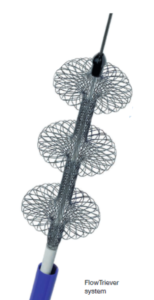Inari Medical has announced positive acute and long-term interim results from the first 500 pulmonary embolism patients enrolled in the FlowTriever outcomes registry (FLASH).
A press release reports that at 48 hours post-procedure, the major adverse event rate and mortality rate were low, at 1.4% and 0.2%, respectively. None of the deaths or major adverse events were device related. Collectively, these pulmonary embolism patients experienced substantial on-table improvements in haemodynamics and symptoms, which translated to six-month improvements in cardiac function, functional status, and quality of life measures. The outcomes were achieved while limiting utilisation of hospital resources, the release adds, with less than 4% of patients receiving adjunctive therapy and a median of zero days in the intensive care unit (ICU) post procedure.
Speaking to Interventional News regarding the growing interest in mechanical thromboaspiration in the treatment of pulmonary embolism patients, Narayan Karunanithy, a consultant interventional radiologist, at Guy’s & St Thomas’ NHS Foundation Trust, London, UK said: “The catheter-based interventional treatments available to treat acute pulmonary embolism have expanded beyond catheter-directed thrombolysis recently to include several percutaneous mechanical thromboaspiration devices. Potential benefits of the latter include the use of the devices in patients with high bleeding risk, when rapid restoration of perfusion to offload the right ventricle is required in high-risk pulmonary embolism and as an alternative to surgical embolectomy in patients with multiple comorbidities. This potentially allows a larger cohort of patients with severe pulmonary embolism to be safely treated. However, at present, there is a lack of robust evidence for these devices demonstrating benefit over standard care. The big research questions are whether high- and intermediate-risk pulmonary embolism patients treated with mechanical thromboaspiration achieve better immediate and long-term outcomes than those managed with standard care anticoagulation and whether the use of the devices is safe. The field is evolving rapidly and in the next few years we are likely to see large-scale studies answer these questions.”

FLASH is a prospective, multicentre, single-arm registry evaluating real-world patient outcomes after treatment of pulmonary embolism with FlowTriever. The 500-patient interim results were presented on 27 October via webcast at Transcatheter Cardiovascular Therapeutics (TCT) 2021 by principal investigator Catalin Toma (University of Pittsburgh Medical Center in Pittsburgh, USA.
“These interim results reinforce the strong safety profile of the FlowTriever system in real-world pulmonary embolism patients, with substantial on-table clinical improvements and immediate symptom relief,” said Toma, who added: “We believe these six-month follow-up data suggest that removal of clot burden without the risks of lytics has potential positive long-term implications for pulmonary embolism patients, including strikingly low rates of hospital readmissions, dyspnoea, CTED (chronic thromboembolic disease), and CTEPH (chronic thromboembolic pulmonary hypertension). These data suggest that treatment with FlowTriever may fundamentally improve the natural course of the disease, and that is tremendously exciting.”
In October, Inari Medical also announced planned enrolment in the PEERLESS trial, a new randomised controlled trial comparing the clinical outcomes of patients with intermediate-high risk pulmonary embolism treated with the FlowTriever System versus catheter-directed thrombolysis. PEERLESS is a prospective, multicentre trial that will include up to 700 patients enrolled in 60 centres in the USA and Europe. The study consists of a primary randomisation cohort of 550 patients, and for patients who cannot be randomised due to an absolute contraindication to thrombolytics, a secondary non-randomised cohort of up to 150 patients. The primary outcome for the trial is a hierarchical composite of outcomes including all-cause mortality, major bleeding events, clinical deterioration and/or bailout, and length of stay in the intensive care unit.
“Historically, due to the major bleeding associated with lytic therapy, physicians needed to carefully weigh a patient’s risk of death against the risk of intervention, reserving advanced treatment for only the sickest of pulmonary embolism patients,” said global co-principal investigator, Carin Gonsalves (Division of Interventional Radiology, University Philadelphia, USA). “By offering patients immediate symptom relief upon removal of significant clot burden without the risks of lytics, the potential for bloodless thrombectomy with the FlowTriever System has fundamentally altered the pulmonary embolism treatment landscape, challenging physicians to rethink risk stratification and the goals of intervention.”













